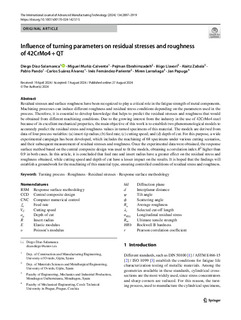
Izenburua
Influence of turning parameters on residual stresses and roughness of 42CrMo4 + QTEgilea (beste erakunde batekoa)
Beste instituzio
Universidad de OviedoCzech Technical University in Prague
Bertsioa
Bertsio argitaratua
Eskubideak
© 2024 The AuthorsSarbidea
Sarbide irekiaArgitaratzailearen bertsioa
https://doi.org/10.1007/s00170-024-14257-5Non argitaratua
International Journal of Advanced Manufacturing Technology Vol. 134. Pp. 2897–2919, 2024Lehenengo orria
2897Azken orria
2919Argitaratzailea
SpringerGako-hitzak
Turning
surface roughness
Residual stresses
response surface methodology ... [+]
surface roughness
Residual stresses
response surface methodology ... [+]
Turning
surface roughness
Residual stresses
response surface methodology
Response surface methodology [-]
surface roughness
Residual stresses
response surface methodology
Response surface methodology [-]
Gaia (UNESCO Tesauroa)
MekanizazioaUNESCO Sailkapena
Eragiketa mekanizatuakLaburpena
Residual stresses and surface roughness have been recognized to play a critical role in the fatigue strength of metal components. Machining processes can induce different roughness and residual stress ... [+]
Residual stresses and surface roughness have been recognized to play a critical role in the fatigue strength of metal components. Machining processes can induce different roughness and residual stress conditions depending on the parameters used in the process. Therefore, it is essential to develop knowledge that helps to predict the residual stresses and roughness that would be obtained from different machining conditions. Due to the growing interest from the industry in the use of 42CrMo4 steel because of its excellent mechanical properties, the main objective of this work is to establish two phenomenological models to accurately predict the residual stress and roughness values in turned specimens of this material. The models are derived from data of four process variables: (a) insert tip radius; (b) feed rate; (c) cutting speed; and (d) depth of cut. For this purpose, a wide experimental campaign has been developed, which includes the machining of 68 specimens under various cutting scenarios, and their subsequent measurement of residual stresses and roughness. Once the experimental data were obtained, the response surface method based on the central composite design was used to fit the models, obtaining a correlation index
higher than 0.9 in both cases. In this article, it is concluded that feed rate and insert radius have a greater effect on the residual stress and roughness obtained, while cutting speed and depth of cut have a lesser impact on the results. It is hoped that the findings will establish a groundwork for the machining of this material type, ensuring controlled conditions of residual stress and roughness. [-]
Bildumak
Item honek honako baimen-fitxategi hauek dauzka asoziatuta:





















